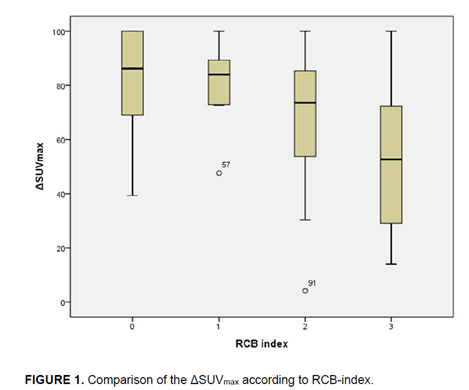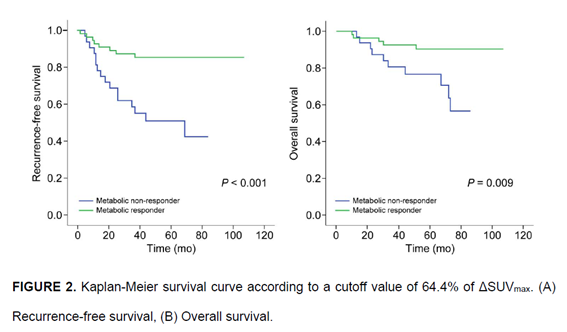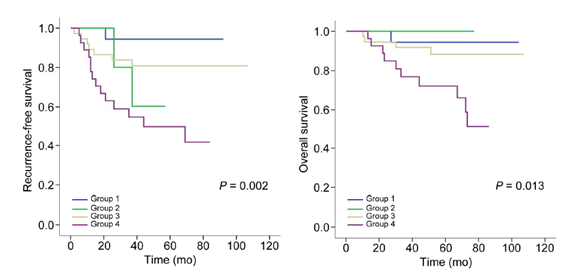글로벌 연구동향
핵의학
![[J Nucl Med.] The Prognostic Impact of Early Change in 18F-FDG PET SUV After Neoadjuvant Chemotherapy in Patients with Locally Advanced Breast Cancer.](/enewspaper/upimages/admin_20160909104738_R.png) 2016년 09월호
2016년 09월호
[J Nucl Med.] The Prognostic Impact of Early Change in 18F-FDG PET SUV After Neoadjuvant Chemotherapy in Patients with Locally Advanced Breast Cancer.연세의대 / 이학운, 이학민, 정준*
- 출처
- J Nucl Med.
- 등재일
- 2016 Aug
- 저널이슈번호
- 57(8):1183-8. doi: 10.2967/jnumed.115.166322. Epub 2016 Mar 31.
- 내용

그림 1. SUV 감소량과 RCB지수와의 상관관계 : RCB 지수가 낮을수록 SUV감소량의 평균값이 크다는 것을 보여줌

그림 2. SUV 감소량에 따른 무병생존 및 전체생존의 차이

그림 3. SUV 감소량과 RCB지수를 이용하여 환자를 4가지 그룹으로 나누어 시행한 생존분석Abstract
SUV, which is an indicator of the degree of glucose uptake in (18)F-FDG PET, can be applied as a prognostic factor in various malignant tumors. We investigated the prognostic impact of early changes in (18)F-FDG PET uptake in patients with locally advanced breast cancer who received neoadjuvant chemotherapy.
METHODS:
We retrospectively identified 87 patients who were treated with neoadjuvant chemotherapy followed by surgery for locally advanced breast cancer. All patients underwent (18)F-FDG PET at baseline and after 3 cycles of neoadjuvant chemotherapy, and the SUVmax of the primary tumor was assessed in each scan. Pathologic slides were retrospectively reviewed, and the residual cancer burden (RCB) index was calculated to estimate pathologic response. RCB-0 indicates no residual disease; patients with residual disease were categorized as RCB-1 (minimal residual disease), RCB-2 (moderate residual disease), or RCB-3 (extensive residual disease).
RESULTS:
There was a negative correlation between reduction in SUVmax and RCB index (r = -0.408; P < 0.001). On multivariate analysis, ΔSUVmax was a significant independent prognostic factor for recurrence-free and overall survival, and the respective adjusted hazard ratios were 0.97 (95% confidence interval, 0.95-0.99; P = 0.001) and 0.97 (95% confidence interval, 0.95-0.99; P = 0.015). When patients were categorized into groups according to pathologic response (RCB index ≤ 1 vs. ≥ 2) and metabolic response (ΔSUVmax ≤ 66.4% vs. > 66.4%), metabolic responders had significantly better recurrence-free and overall survival than metabolic nonresponders among poor-pathologic-response patients. In contrast, among metabolic responders, there was no survival difference according to pathologic response.
CONCLUSION:
The early change in (18)F-FDG PET SUVmax after third-cycle neoadjuvant chemotherapy is an independent and good prognostic marker beyond pathologic response in patients with locally advanced breast cancer. We suggest that in these patients, the use of ΔSUVmax should be considered not only for the assessment of tumor response but for the prediction of posttreatment outcome.
Author information
Lee HW1, Lee HM2, Choi SE3, Yoo H4, Ahn SG1, Lee MK5, Jeong J6, Jung WH3.
1Department of Surgery, Gangnam Severance Hospital, Yonsei University College of Medicine, Seoul, Republic of Korea.
2Department of Surgery, MizMedi Women's Hospital, Seoul, Republic of Korea.
3Department of Pathology, Gangnam Severance Hospital, Yonsei University College of Medicine, Seoul, Republic of Korea.
4Biostatistics Collaboration Lab, Yonsei University College of Medicine, Seoul, Republic of Korea; and.
5Department of Nuclear Medicine, Gangnam Severance Hospital, Yonsei University College of Medicine, Seoul, Republic of Korea.
6Department of Surgery, Gangnam Severance Hospital, Yonsei University College of Medicine, Seoul, Republic of Korea gsjjoon@yuhs.ac.
- 키워드
- 18F-FDG PET; breast cancer; neoadjuvant chemotherapy; standardized uptake value
- 연구소개
- 강남세브란스병원 유방암센터에서 2004년 1월부터 2011년 12월까지 87명의 선행화학요법을 받은 국소진행성유방암 환자를 대상으로 본 연구를 진행하였다. 항암치료 시작 전과 3주기의 항암화학요법 후에 PET 검사를 시행하였다. 모든 환자에서 RCB 지수 Residual Cancer Burden Index)를 계산하였는데, RCB 0은 완전관해, RCB1은 최소잔종종양, RCB2는 중간잔종종양, RCB3은 광범위잔존종양을 의미한다. 표준화섭취계수감소량과 RCB 지수에는 의미있는 역상관관계가 관찰되었다. (correlation coefficient:=-.408, p<0.001). 포도당섭취계수가 66.4% 이상 감소한 치료반응군은 포도당섭취계수가 66.4% 미만인 치료비반응군과 비교하여 무병생존 및 전체생존에 대한 위험도가 각각 0.31 및 0.20으로 좋은 생존결과를 보였다. 포도당섭취계수의 감소량 및 RCB 지수를 이용하여 환자를 4그룹으로 나누었을 때, RCB 지수가 높은 환자에서는 포도당섭취계수의 감소량에 따라 생존 차이가 관찰된 반면, 포도당섭취계수에 의한 치료반응군에서는 RCB 지수에 따른 생존 차이가 관찰되지 않았다. 항암치료 시작 전의 PET 검사와 3주기 항암치료 후의 PET검사에서 포도당 섭취계수의 감소 정도를 평가하여, 포도당 섭취계수가 감소할수록 무병생존 및 전체생존율이 높아지는 것은 87명의 유방암 환자에서 확인하였다. 포도당섭취계수가 66.4% 이상 감소한 치료반응군은 포도당섭취계수가 66.4% 미만인 치료비반응군과 비교하여 무병생존 및 전체생존에 대한 위험도가 각각 0.31 및 0.20으로 좋은 생존결과를 보였다. 특히, MD Anderson 병원에서 개발한 선행화학요법 환자의 반응 평가 및 생존예측에 있어서 중요한 병리인자로 알려진 RCB 지수 (Residual Cancer Burden Index) 와 비교하였는데, 포도당섭취계수의 감소는 RCB 지수와 의미 있는 상관관계를 보였다. 또한, 포도당섭취계수의 감소는 RCB 지수보다 더 뛰어난 생존 예측력을 보였다. 이는 RCB 지수가 높은 환자에서는 포도당섭취계수의 감소량에 따라 생존 차이가 관찰된 반면, 포도당섭취계수에 의한 치료반응군에서는 RCB 지수에 따른 생존 차이가 관찰되지 않는 것으로 확인할 수 있었다. 항암 치료 전 후로 PET 검사 시행을 통해 조기에 치료 반응성을 평가할 수 있고, 치료 반응이 좋은 환자는 최종 생존 결과도 좋을 것으로 예측할 수 있다는 연구 결과이며, 동시에 치료에 대한 반응이 불량할 것으로 예상되는 환자에 대한 조기 선별이 가능하다고 할 수 있겠다. 향후 PET 검사를 이용하여 조기 선별된 치료반응 불량군에 대하여 더 많은 연구가 필요하다.
- 덧글달기








편집위원
유방암에서 조기에 FDG 섭취 변화의 임상적 의미를 밝힌 새로운 연구결과로, 임상 핵의학자에게 관심을 많이 끌 수 있다.
덧글달기닫기2016-08-31 15:27:52
등록